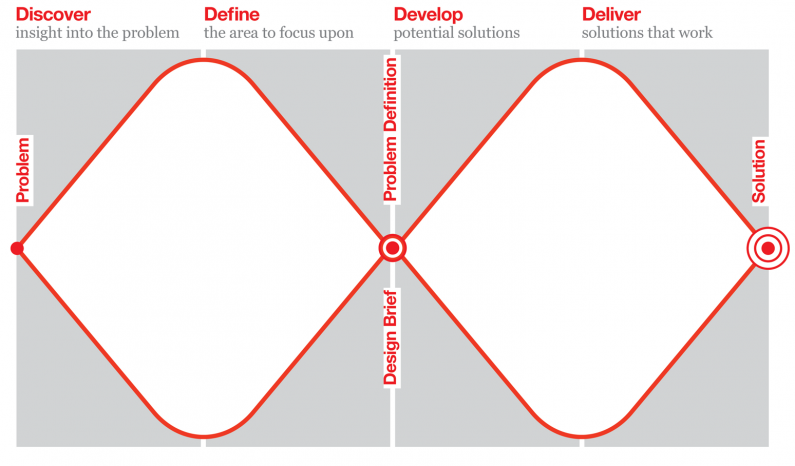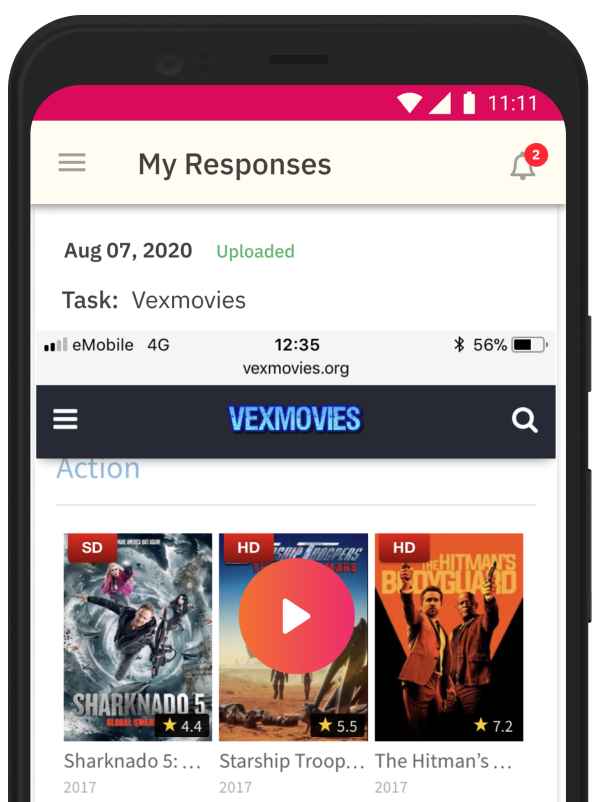Optimizing the Double-Diamond with Mobile Ethnography
Double-Diamond
The 2005 British Design Council’s Double-Diamond strategy is frequently used around the world to guide design processes and to assist with innovation. This tool serves as a mental model and guide for how to approach each phase of the design process. It helps designers understand where they are in their process and what activities are needed to move the project forward. This strategy has been adopted by some of the leading user experience, product, customer experience designers..
The Double-Diamond consists of two distinct ideation phases and four core process steps. Each diamond has two distinct types of ideation: diverging and converging. The diverging state is the one that involves ideation, brainstorming, and exploring different ideas and solutions.
The converging state involves narrowing down and synthesizing the ideas to come up with the best possible end results. These ideations are aligned with four core steps:
1- Discover (diverge)
2- Design (converge)
3- Develop (diverge)
4- Deliver (converge)
While the double-diamond strategy can loosely be applied to most phases of design work, each step also encapsulates various activities to facilitate the design process on a more tangible level. Mobile ethnography [what is mobile ethnography?] has the capability to improve efficiency at each level of the diamond. This article will highlight mobile ethnography opportunities at each step.
Double-Diamond Step 1: Discover
During the first step, discover, it’s important to gather as much information and to explore as many ideas as possible. Both quality and quantity play a part in this step. The more targeted the participant base and the greater the number of participants, the higher the quality of data will be as the end result. Two activities that mobile ethnography can facilitate in this phase are observation and diary studies
Observation
One of the best ways to gather information is to observe. When it comes to observing behavior, larger sample sizes tend to provide more accurate results than smaller ones. However, constraints on the researchers time, physical/geographical availability, and budget have typically prevented observations of large samples. Mobile ethnography allows for asynchronous observations via participant mobile recordings. Thus, allowing for a greater set of observations at a fraction of resources.
Longitudinal Diary Studies
Longitudinal diary studies are one of the best tools for capturing experience information over a specific timeframe. These types of studies typically have participants keep notes on their activities for set periods of time, be it a week, month, or longer. Mobile ethnography (online ethnography) provides participants and researchers with a mobile ethnography app and platform that makes it easy to easily store information and to later organize the information with features like transcription, tagging, and filtering.
Double-Diamond Step 2: Design
During the second step, design, the data gathered from discovery is synthesized and ideas are narrowed down into the most effective solution. One activity that facilitates the design convergence process is customer journey mapping or capturing the user’s experience.
Customer Journey Mapping
Customer journey mapping takes information gathered from participants, synthesized into the most common workflow, and plotted as steps in chronological order. The end deliverable is used to align a larger team on who they will be developing for, along with pain points and opportunities that need to be accounted for in the roadmap.
Mobile ethnography can be immensely helpful with facilitating journey maps. The information collected during the discovery phase from different tasks and prompts will be captured and neatly stored in the system. This will be helpful when analyzing findings during the design phase for determining each journey map phase and step. Emotional states are also captured in a timely manner after task completion. Metrics such as CSAT and NPS score plot out highs and lows of each user journey as well as quickly aggregate multiple subject journey sets. This takes the guesswork out of one of the most subjective phases of the journey map.
More information on how Indeemo can assist with journey mapping can be found here.
Double-Diamond Step 3: Develop
During the third step, strategy is applied in several different ways. This diverging step looks at what can be built with the given information. Tech departments usually interpret this step as the area to develop a product. However, Customer Experience teams often use this step for scaling the customer journey into a service blueprint.
Service blueprints layer the customer journey with the journey of organizational touchpoints that the customer has with the company or organization. The customer journey is typically referred to as the front stage, and the business journey that supports the customer journey is referred to as the backstage.
Mobile ethnography expedites this step by allowing for quick data collection and aggregation. Capturing employee workflows can be challenging and time-consuming. Leveraging mobile ethnography tools allows for employees to easily and quickly provide timely feedback and recordings of their main workflows. All these artifacts are stored in one place, making it easy to find, filter, and organize into the service blueprint.
More detailed information on how Indeemo can help with service blueprints can be found here.
Double-Diamond Step 4: Deliver
Finally, the fourth step, deliver, indicates the product has been set in the wild and feedback is needed for iteration and closing the loop. With an agile approach encouraging organizations to fail fast, it’s important to know when failure has occurred, what failed, and how it can be fixed. Testing and getting feedback from the customer base is the focus of this final step.
Testing is typically done prior to launching a solution. Typically, a prototype or a small beta test group will be used. Mobile ethnography can play a role here by allowing participants to record their experiences using a mobile ethnography app like Indeemos (on their mobile device) or using their mobile device to record their interaction with the solution if it’s not in a mobile setting. Asynchronous workflows, a larger pool of testers, and conveniently archived feedback materials allow for a more thorough analysis of the solution state. This can result in timely iteration and a better experience for the users at launch.
Feedback loop is used when the product has launched and is living in the wild. It’s typically difficult for teams to monitor every single aspect of the product released. However, it’s important to get timely feedback in order to take action and to make necessary iterations. Mobile ethnography allows for easy follow-up with participants on projects even after they have been launched. Large groups of participants can provide timely feedback that is nicely organized and stored for review.
In Summary
The merits of the Double-Diamond strategy for design and product innovation is only growing in popularity. Leveraging mobile ethnography saves time and money on conducting research without sacrificing the quality of each study. By applying mobile ethnography to each step of the Double-Diamond, it will enhance both the research and design workflows while improving the end-product experience for the user.
Testimonial: what our customers like about us
Check out what our customers say about us on G2 Crowd
“I was amazed by how user-friendly and ergonomic both the participant app and the researcher online platform were”





